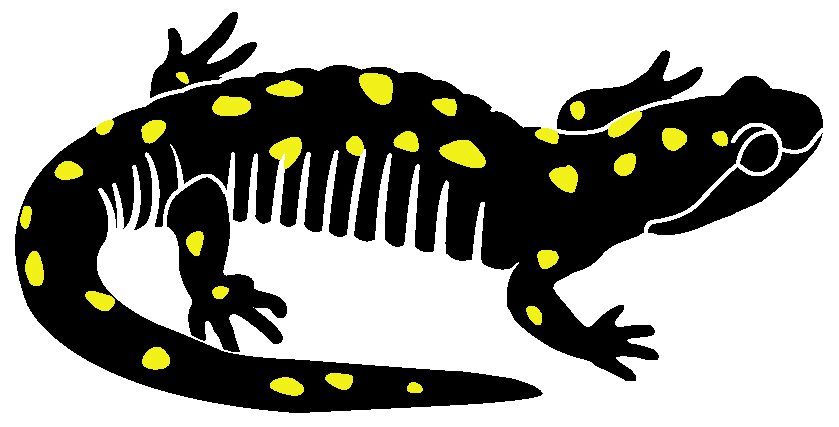Marbled Salamander
Ambystoma opacum
Adults
The marbled salamander (3-5") has a distinctive pattern of white or grayish spots and bars on a black, purplish-black, or grayish body. The animal is not large but has a stout, pudgy appearance. The patterning on the male is white, while that of the females tends to be more grayish. These salamanders are fossorial, utilizing animal burrows most of the time. They are occasionally found under logs and rocks in their deciduous forest habitat, but are rarely seen above ground except on rainy nights in late summer and early fall. Their diet consists of invertebrates, including earthworms, crickets, ants, snails, slugs, and various types of beetles.
Eggs
Marbled salamanders are late summer breeders. Both males and females migrate to the area surrounding a dry vernal pool in late August -September, perhaps as late as October. Males court females and produce spermatophores from which the females obtain sperm. The female constructs a nest under moss, leaves or cover objects in a dry area of the pool basin and deposits between 50-200 small transparent eggs.
The eggs quickly become darkened with soil and leaf particles. She remains with the eggs until hatched, warding off predators such as small mammals (e.g. shrews), newts, and insects. The eggs hatch when covered with water as the pool fills. If flooding does not take place before winter, the female will abandon the nest to seek cover for hibernation.
The elevation at which the nest is built in the pool is particularly important to hatching and larval development. If the eggs are in the deepest area of the pool, they might be flooded with just a light rain, hatch, and then die if the water evaporates. Eggs at too high an elevation might not be flooded during the fall but have to await spring rains, while enduring the ravages of predation and winter temperatures. Most nests are constructed at a median location, but the best area varies with each year’s weather patterns.
Larvae
Larvae develop within the egg and hatch when the eggs are flooded. Because of this fall hatching, the marbled larvae are likely to be the only salamander larvae that would be found under pool ice in the winter or in a pool when it thaws in the early spring. Rarely, spotted salamander larvae will overwinter and be seen under the ice or in early spring. A marbled larva can be distinguished from the occasional spotted larva by a row of light spots on its sides and by the pattern of uniform black stippling on its white throat.
Marbled larvae are carnivorous and feed throughout the winter, under the ice, on zooplankton and available macroinvertebrates. As they grow, they feed on larger prey, eventually consuming most any moving creature they can get in their mouths, including dytiscid and haliplid beetles, snails, mayfly nymphs and damselfly nymphs. By spring, they are able to feed on the hatching larvae of wood frogs and other species of mole salamander. Because they hatch in the fall, marbled larvae eat a different size class of food in the spring than consumed by hatching spotted, Jefferson or blue-spotted larvae. There is little real competition for food among these species in the spring. However, there is a certain amount of predation by the marbled on the other mole salamander larvae. Marbled larvae transform to the land-dwelling form in May and June. Upon metamorphosis, they have a grayish-blue spotted pattern on a purplish-black body. Within a few weeks, the spots come together to form the characteristic adult pattern.

The marbled salamander, Ambystoma opacum, has a light on dark pattern that distinguishes it from all other New England salamanders.

The female constructs a nest in a dry vernal pool under moss or leaves and lays eggs sometime in late August through September.

Larvae develop in the egg and hatch when the pool is flooded in the fall season.

Marbled salamander larvae have a speckled throat which distinguishes them from the other local mole salamanders.
Conservation Note
The marbled salamander is at the northern limit of its geographical range in MA and is therefore quite uncommon and local populations are relatively small. As of January 2015, approximately 85 local populations had been documented among 61 towns since 1990.
Marbled Salamander is legally protected and listed as Threatened pursuant to the Massachusetts Endangered Species Act (M.G.L. c. 131A) and implementing regulations (321 CMR 10.00).

Marbled Salamander
For further information, consult the NHESP Fact Sheet for Marbled Salamander.

Since marbled larvae hatch in the fall, they feed on a different size class of food in the spring and do not compete with blue-spotted and Jefferson larvae. This marbled larva is seen with a spotted salamander egg mass.

Marbled larvae feed on inverebrates in the water as well as the larvae of other amphibians. This larva has pulled a caddisfly larva from its protective stick case.

